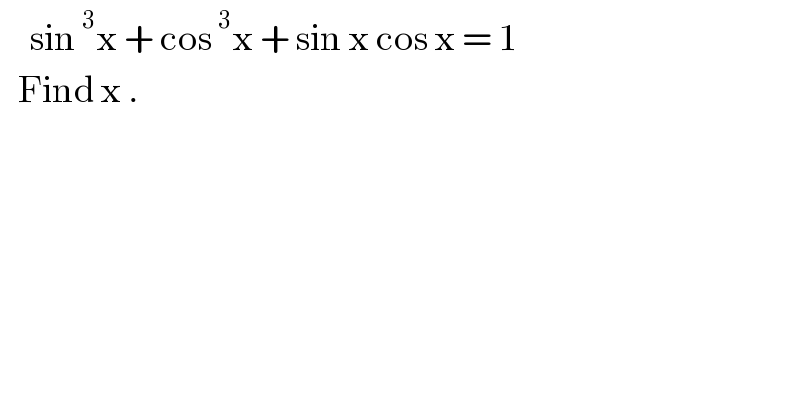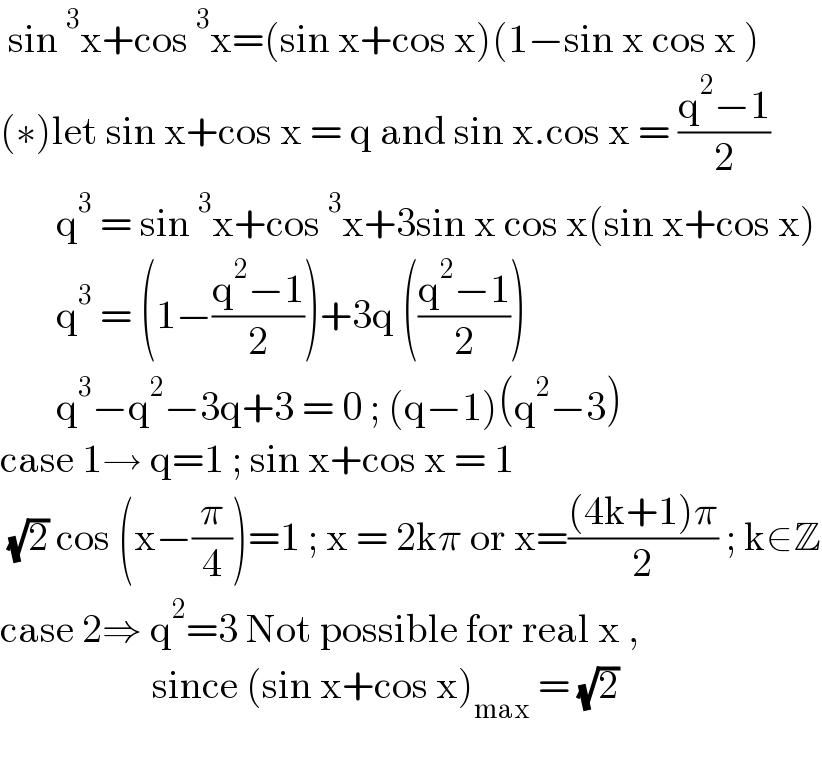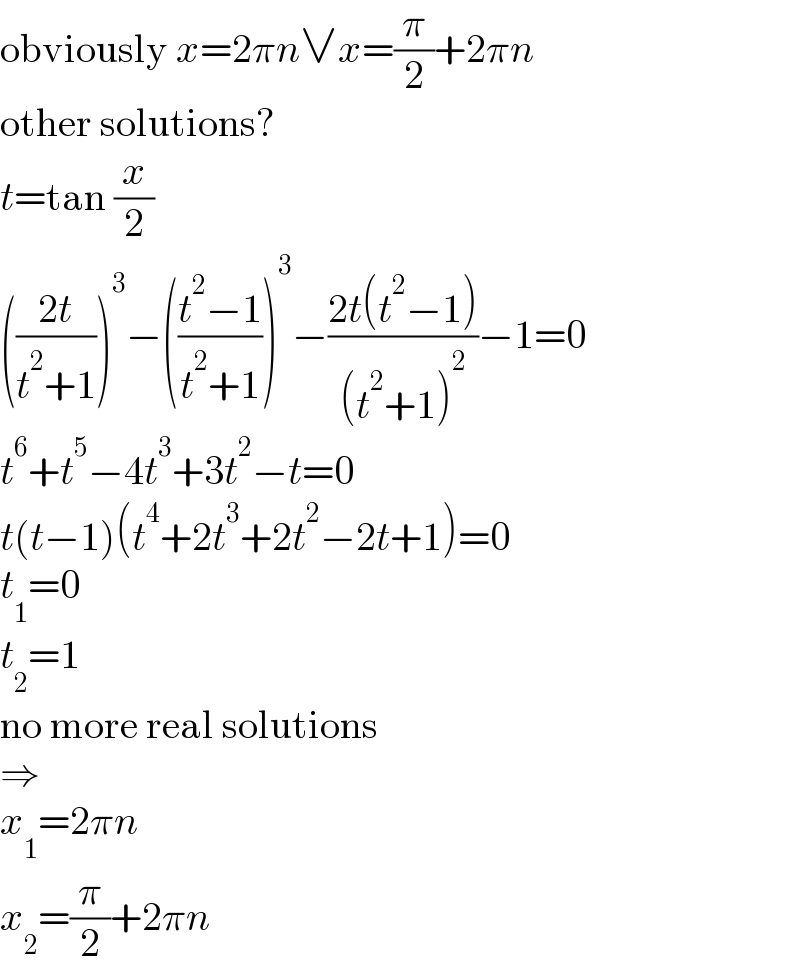
Question Number 128743 by bemath last updated on 10/Jan/21

$$\:\:\:\:\:\mathrm{sin}\:^{\mathrm{3}} \mathrm{x}\:+\:\mathrm{cos}\:^{\mathrm{3}} \mathrm{x}\:+\:\mathrm{sin}\:\mathrm{x}\:\mathrm{cos}\:\mathrm{x}\:=\:\mathrm{1} \\ $$$$\:\:\:\mathrm{Find}\:\mathrm{x}\:. \\ $$
Answered by liberty last updated on 10/Jan/21

$$\:\mathrm{sin}\:^{\mathrm{3}} \mathrm{x}+\mathrm{cos}\:^{\mathrm{3}} \mathrm{x}=\left(\mathrm{sin}\:\mathrm{x}+\mathrm{cos}\:\mathrm{x}\right)\left(\mathrm{1}−\mathrm{sin}\:\mathrm{x}\:\mathrm{cos}\:\mathrm{x}\:\right) \\ $$$$\left(\ast\right)\mathrm{let}\:\mathrm{sin}\:\mathrm{x}+\mathrm{cos}\:\mathrm{x}\:=\:\mathrm{q}\:\mathrm{and}\:\mathrm{sin}\:\mathrm{x}.\mathrm{cos}\:\mathrm{x}\:=\:\frac{\mathrm{q}^{\mathrm{2}} −\mathrm{1}}{\mathrm{2}} \\ $$$$\:\:\:\:\:\:\:\mathrm{q}^{\mathrm{3}} \:=\:\mathrm{sin}\:^{\mathrm{3}} \mathrm{x}+\mathrm{cos}\:^{\mathrm{3}} \mathrm{x}+\mathrm{3sin}\:\mathrm{x}\:\mathrm{cos}\:\mathrm{x}\left(\mathrm{sin}\:\mathrm{x}+\mathrm{cos}\:\mathrm{x}\right) \\ $$$$\:\:\:\:\:\:\:\mathrm{q}^{\mathrm{3}} \:=\:\left(\mathrm{1}−\frac{\mathrm{q}^{\mathrm{2}} −\mathrm{1}}{\mathrm{2}}\right)+\mathrm{3q}\:\left(\frac{\mathrm{q}^{\mathrm{2}} −\mathrm{1}}{\mathrm{2}}\right) \\ $$$$\:\:\:\:\:\:\:\mathrm{q}^{\mathrm{3}} −\mathrm{q}^{\mathrm{2}} −\mathrm{3q}+\mathrm{3}\:=\:\mathrm{0}\:;\:\left(\mathrm{q}−\mathrm{1}\right)\left(\mathrm{q}^{\mathrm{2}} −\mathrm{3}\right) \\ $$$$\mathrm{case}\:\mathrm{1}\rightarrow\:\mathrm{q}=\mathrm{1}\:;\:\mathrm{sin}\:\mathrm{x}+\mathrm{cos}\:\mathrm{x}\:=\:\mathrm{1}\: \\ $$$$\:\sqrt{\mathrm{2}}\:\mathrm{cos}\:\left(\mathrm{x}−\frac{\pi}{\mathrm{4}}\right)=\mathrm{1}\:;\:\mathrm{x}\:=\:\mathrm{2k}\pi\:\mathrm{or}\:\mathrm{x}=\frac{\left(\mathrm{4k}+\mathrm{1}\right)\pi}{\mathrm{2}}\:;\:\mathrm{k}\in\mathbb{Z} \\ $$$$\mathrm{case}\:\mathrm{2}\Rightarrow\:\mathrm{q}^{\mathrm{2}} =\mathrm{3}\:\mathrm{Not}\:\mathrm{possible}\:\mathrm{for}\:\mathrm{real}\:\mathrm{x}\:,\:\: \\ $$$$\:\:\:\:\:\:\:\:\:\:\:\:\:\:\:\:\:\:\:\mathrm{since}\:\left(\mathrm{sin}\:\mathrm{x}+\mathrm{cos}\:\mathrm{x}\right)_{\mathrm{max}} \:=\:\sqrt{\mathrm{2}}\: \\ $$$$ \\ $$
Answered by MJS_new last updated on 10/Jan/21

$$\mathrm{obviously}\:{x}=\mathrm{2}\pi{n}\vee{x}=\frac{\pi}{\mathrm{2}}+\mathrm{2}\pi{n} \\ $$$$\mathrm{other}\:\mathrm{solutions}? \\ $$$${t}=\mathrm{tan}\:\frac{{x}}{\mathrm{2}} \\ $$$$\left(\frac{\mathrm{2}{t}}{{t}^{\mathrm{2}} +\mathrm{1}}\right)^{\mathrm{3}} −\left(\frac{{t}^{\mathrm{2}} −\mathrm{1}}{{t}^{\mathrm{2}} +\mathrm{1}}\right)^{\mathrm{3}} −\frac{\mathrm{2}{t}\left({t}^{\mathrm{2}} −\mathrm{1}\right)}{\left({t}^{\mathrm{2}} +\mathrm{1}\right)^{\mathrm{2}} }−\mathrm{1}=\mathrm{0} \\ $$$${t}^{\mathrm{6}} +{t}^{\mathrm{5}} −\mathrm{4}{t}^{\mathrm{3}} +\mathrm{3}{t}^{\mathrm{2}} −{t}=\mathrm{0} \\ $$$${t}\left({t}−\mathrm{1}\right)\left({t}^{\mathrm{4}} +\mathrm{2}{t}^{\mathrm{3}} +\mathrm{2}{t}^{\mathrm{2}} −\mathrm{2}{t}+\mathrm{1}\right)=\mathrm{0} \\ $$$${t}_{\mathrm{1}} =\mathrm{0} \\ $$$${t}_{\mathrm{2}} =\mathrm{1} \\ $$$$\mathrm{no}\:\mathrm{more}\:\mathrm{real}\:\mathrm{solutions} \\ $$$$\Rightarrow \\ $$$${x}_{\mathrm{1}} =\mathrm{2}\pi{n} \\ $$$${x}_{\mathrm{2}} =\frac{\pi}{\mathrm{2}}+\mathrm{2}\pi{n} \\ $$
